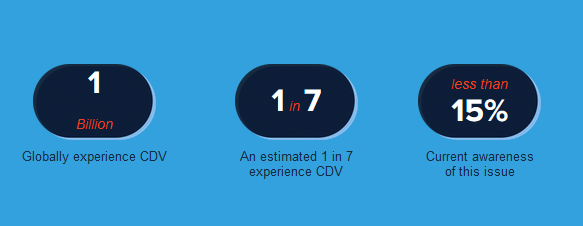 |
At its heart, Childhood Domestic Violence (CDV) occurs when a person grows up living in a home with domestic violence. |
Domestic violence is violence between parents or violence towards a parent, perhaps from a stepparent or significant other. The violence can be physical, non-physical, or both, but it is NOT directed towards the child.
CDV has little awareness compared to other adversities that many children face, such as physical, sexual, and emotional abuse, and physical and emotional neglect. Yet, CDV often co-occurs alongside other adversities prevalent in a home, and the cycles of violence and neglect can repeat for generations.
How is Childhood Domestic Violence (CDV) different from domestic violence?
Most people do not distinguish Childhood Domestic Violence (CDV) from domestic violence. When you grow up in a home with domestic violence, you may not be the target of the violence in any form.
We have found that researchers refer to children growing up in homes with domestic violence as “witnesses” to domestic violence, which implies the impact for these children is temporary and non-traumatic. After all, why would witnessing domestic violence be as hurtful as being the target of the violence?
Therein lies one of the roadblocks to the understanding of CDV – these children are not only witnesses to the violence, but they share in the environment and experience of it. More and more research, including studies by the National Library of Medicine, indicates that CDV inflicts the same, and sometimes greater, negative impacts on adulthood as being the one physically or emotionally abused.
How is Childhood Domestic Violence (CDV) different from child abuse?
Every April during National Child Abuse Prevention Month, many concerned organizations and individuals unite to bring awareness to and rally for an end to child abuse. The issue affects more than 1 million children in the United States annually.
“Most people know of or can imagine the extreme negative effects of child abuse,” said Dr. Linda Olson, licensed psychologist and psychotherapist. “But what many fail to grasp is the similar impact of Childhood Domestic Violence on a person, as well as its strong relation to child abuse. And those are key pieces of the puzzle in addressing both issues.”
Domestic violence and child abuse are massive social issues, but there is a common connection. CDV rewires the brain–growing up with domestic violence can teach people to believe lies about themselves. Although people are aware of what child abuse is, the awareness of CDV remains low. Many children of domestic violence, now adults, do not have a name for what they feel, and do not connect the dots. They do not understand how CDV negatively shapes their adult lives.
Childhood Domestic Violence (CDV) is the Common Connection Between Childhood Adversities
Research shows children see 90% of the violence that occurs, and its profound impact often lingers long after they’ve left their childhood homes. The statistics connecting child abuse, domestic violence, and CDV show how critical it is to understand what CDV is and how an increased awareness of CDV can help to prevent these adversities simultaneously:
In households with domestic violence, there is a 30-60% chance that child abuse is also taking place (a rate 15X higher than the average), indicating the key connection that child abuse is more likely to occur in homes where domestic violence is occurring.

The connection and relevance to domestic violence are equally profound. Children of domestic violence are 2-3 times more likely to repeat the cycle of violence in adulthood, as growing up with domestic violence is the single best predictor of whether or not someone will become a victim or perpetrator of domestic violence in adulthood.
How can we combat Childhood Domestic Violence (CDV)?
First, ask yourself this question: Did you grow up living with domestic violence? Your answer has already increased awareness of the issue and impact, and helped you gain greater control of your thoughts.
If you are a child of domestic violence, you must understand you are not alone. CDV’s impact is of epidemic proportions. Globally, it impacts 1 in 7 people. It affects 15 million children and 40 million adults in the U.S alone.
There are 275 million children globally currently growing up in homes with domestic violence or CDV.
Although CDV is a widespread global issue, awareness of this problem is extremely low. In a recent survey, we found that fewer than 15% of people had ever heard of childhood domestic violence.

Sharing what you know and helping yourself and others connect the dots are the keys to building higher awareness of CDV.
Here are some more ways to increase awareness:
- Understand the differences between CDV, domestic violence, child abuse, and other adversities & share this increased understanding
- Be willing to talk about your experience to someone who cares or who will listen when you feel ready to work through your trauma
- Get involved with the Childhood Domestic Violence Association
To learn more about CDV and our work, visit cdv.org.

